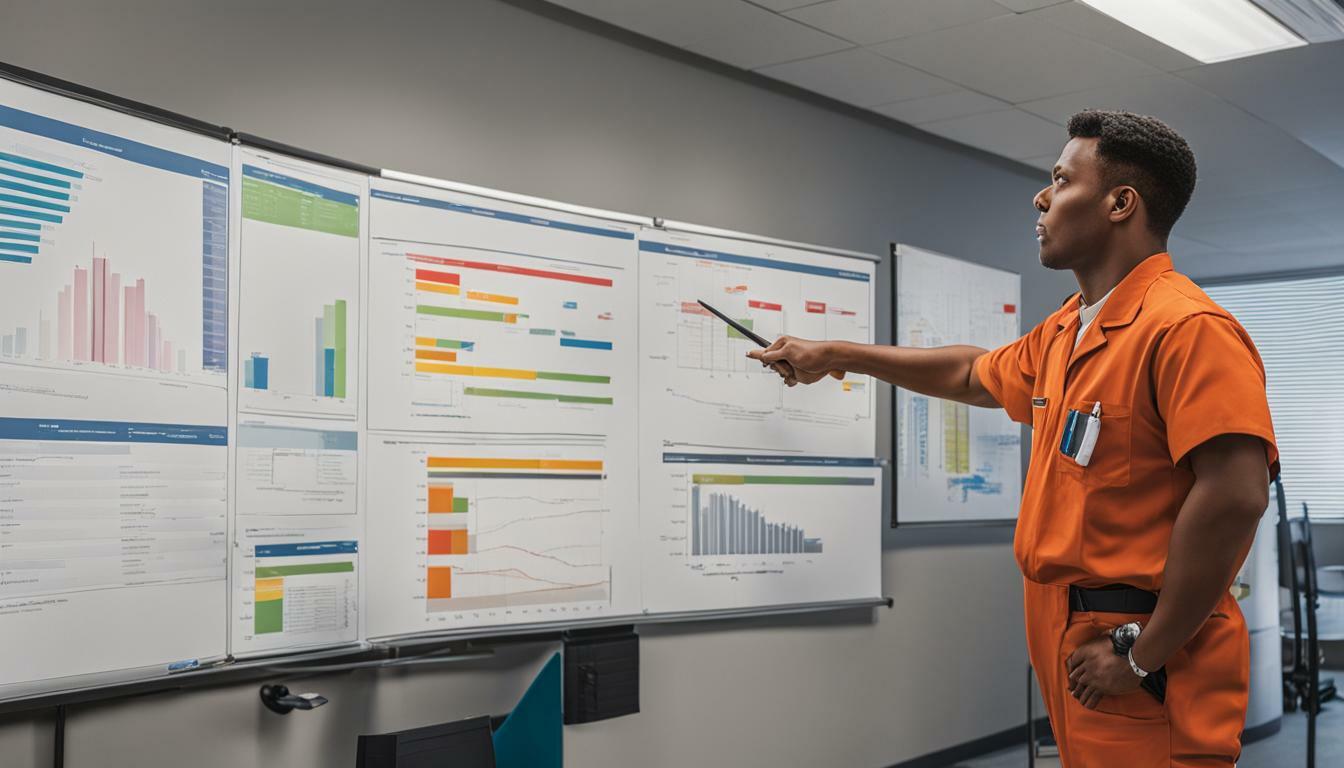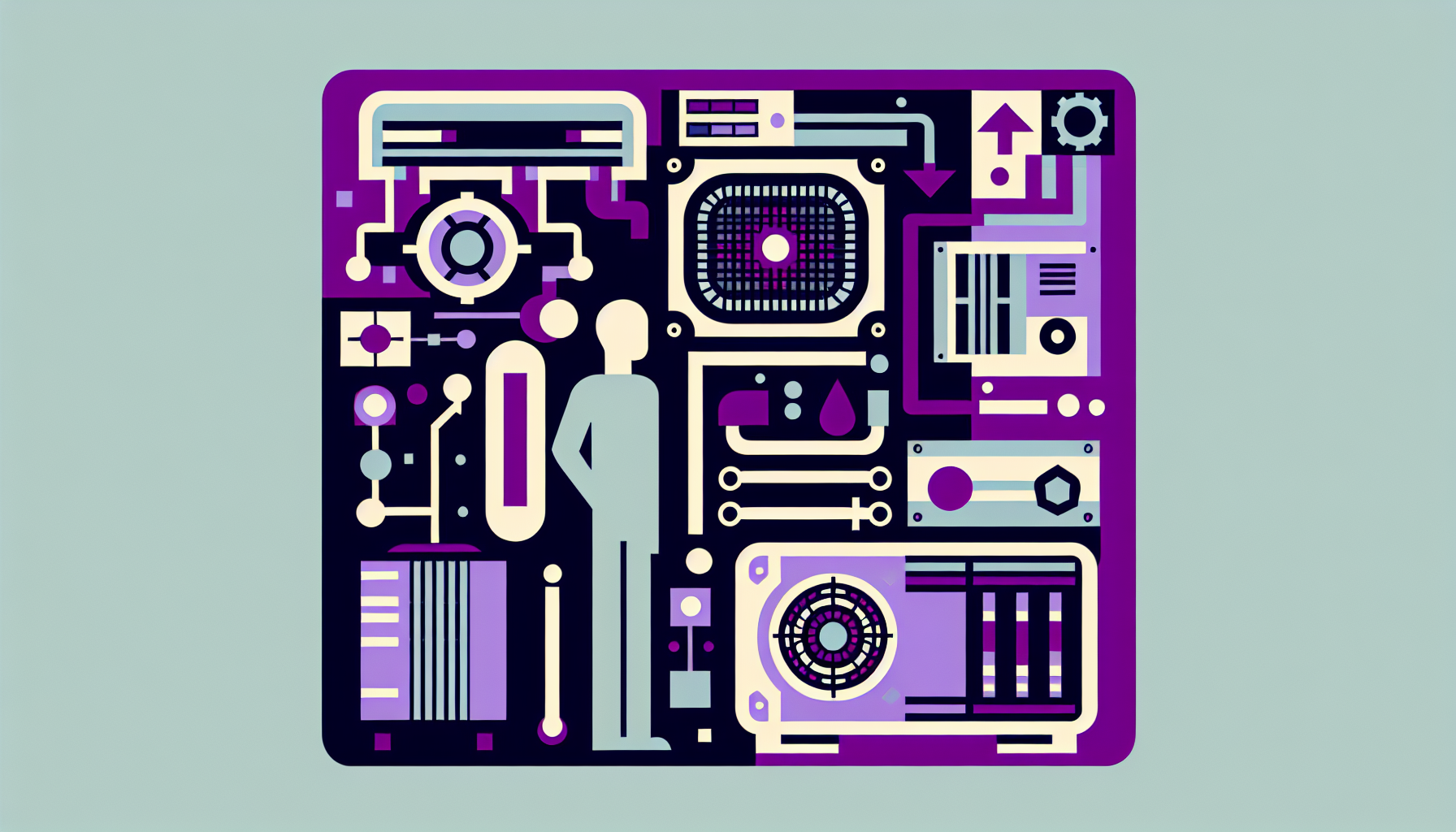Managing HVAC field service technicians is crucial for optimizing productivity and ensuring efficient service delivery in the HVAC industry. Effectively managing technicians can lead to improved customer satisfaction, reduced response times, and increased profitability. In this article, we will explore various strategies and technologies that can help you better manage your HVAC field service technicians.
Key Takeaways:
- Prioritizing service requests and integrating systems can streamline technician management.
- Utilizing video as a tool for field service operations enhances technician skill development and training.
- A skilled office dispatcher plays a vital role in coordinating technician workloads and ensuring smooth teamwork.
- Streamlining customer information and job scheduling improves technician performance evaluation and productivity.
- Sending service reminders and utilizing waiting lists help manage technician workloads effectively.
Prioritizing Service Requests and Integrating Systems
Prioritizing service requests and integrating systems can greatly streamline technician management processes, leading to improved scheduling and performance tracking. The use of Microsoft Dynamics 365 for Field Service, for example, can be a game-changer in the HVAC industry. This comprehensive platform allows for the compilation and prioritization of service requests, ensuring that urgent or high-priority issues are addressed promptly. By automatically assigning technicians and parts to each incident, the system optimizes resource allocation and minimizes downtime.
With Microsoft Dynamics 365 for Field Service, technicians can access a customer service portal, providing them with real-time access to customer history, equipment details, and work order information. This empowers them to deliver personalized experiences and resolve issues efficiently. The system can also track technician performance, allowing managers to evaluate productivity, response times, and overall customer satisfaction. By utilizing this technology, companies can optimize their technician scheduling, ensuring that skilled professionals are assigned to the right jobs at the right time.
In addition to integrating systems, video can also play a crucial role in enhancing field service operations. By using video, technicians can remotely diagnose equipment issues, provide real-time visual demonstrations to customers, and even create training and instructional videos for continuous skill development. This not only improves the efficiency of service delivery but also enables technicians to acquire new skills and knowledge. With the right video tools, technicians can access and share vital information, ensuring effective problem-solving and reducing the need for multiple site visits.
| Benefits of Prioritizing Service Requests and Integrating Systems: |
|---|
| Optimized resource allocation |
| Efficient technician scheduling |
| Real-time access to customer history and work order information |
| Improved technician performance tracking |
| Enhanced problem-solving capabilities through video diagnostics |
| Continuous skill development through training videos |
Overall, by prioritizing service requests and integrating systems, HVAC companies can improve the management of field service technicians. Through the use of platforms like Microsoft Dynamics 365 for Field Service and leveraging video technology, companies can optimize scheduling practices, deliver personalized customer experiences, enhance technician performance, and foster continuous improvement in the HVAC industry.
Utilizing Video for Field Service Operations
Video can revolutionize field service operations by empowering technicians with valuable training resources and enabling seamless equipment diagnostics. By leveraging video technology, HVAC service companies can enhance technician skill development and improve the overall quality of service provided to customers.
One of the key benefits of using video in field service operations is the ability to create training and instructional resources. Technicians can access video tutorials and demonstrations that provide in-depth guidance on various repair and maintenance procedures. This allows them to acquire new skills and expand their knowledge base, ultimately boosting their efficiency and effectiveness in the field.
Furthermore, video enables real-time equipment diagnostics. Technicians can use video technology to visually inspect equipment, identify potential issues, and troubleshoot problems remotely. By transmitting live video feeds to support teams or senior technicians, they can receive immediate guidance and expert assistance, significantly reducing downtime and improving first-time fix rates.
By implementing video technology in field service operations, HVAC companies can unlock a wealth of benefits. From effective technician training to enhanced equipment diagnostics, video empowers technicians to deliver exceptional service and ensures that customers receive prompt, accurate, and efficient solutions to their HVAC needs.
| Benefits of Utilizing Video for Field Service Operations: |
|---|
| Improved technician skill development and knowledge acquisition |
| Real-time equipment diagnostics for faster problem resolution |
| Reduced downtime and improved first-time fix rates |
Enhancing Office Dispatcher Capabilities
A competent office dispatcher plays a vital role in effectively coordinating technician teams and optimizing workloads for improved efficiency. By ensuring clear communication between the office and field technicians, the dispatcher can keep the workflow streamlined and ensure that jobs are assigned to the most suitable technicians based on their skills and availability.
One way the office dispatcher can enhance their capabilities is by utilizing a comprehensive dispatch software that provides real-time insights into technician locations and workloads. This allows them to make informed decisions when assigning jobs, minimizing travel time and maximizing the number of service requests completed within a given timeframe.
In addition to efficient job allocation, an office dispatcher can also optimize technician workloads by grouping similar jobs together. By categorizing service requests based on location or type, the dispatcher can minimize travel time and ensure that technicians can efficiently handle multiple jobs in the same area. This not only improves overall productivity but also enhances customer satisfaction by reducing wait times and minimizing disruptions to their daily routines.
| Benefits of Enhancing Office Dispatcher Capabilities: |
|---|
| Effective coordination of technician teams |
| Optimization of workloads for improved efficiency |
| Minimized travel time for technicians |
| Informed decision-making for job assignments |
| Maximized number of completed service requests |
| Reduced wait times for customers |
Streamlining Customer Information and Job Scheduling
Streamlining customer information and implementing smart job scheduling practices can lead to enhanced technician productivity and more accurate performance evaluation. By centralizing customer data and making it easily accessible, HVAC companies can ensure that technicians have all the relevant information they need to provide efficient and personalized service. This includes details such as previous service history, equipment specifications, and customer preferences. With this information at their fingertips, technicians can arrive at each job fully prepared, minimizing delays and maximizing customer satisfaction.
When it comes to job scheduling, grouping jobs based on location or type can significantly improve efficiency. By organizing service calls in a logical and streamlined manner, technicians can minimize travel time between jobs and complete more tasks in a day. This not only increases productivity but also contributes to better customer service by reducing wait times for appointments. With the help of integrated scheduling software, HVAC companies can optimize their technician’s routes and ensure that each day’s workload is balanced and manageable.
Additionally, implementing a system to send service reminders to customers can help prevent missed appointments and improve overall scheduling accuracy. By automatically notifying customers of upcoming service visits, HVAC companies can reduce no-shows and ensure that technicians are utilized effectively. Furthermore, utilizing a waiting list for unassigned jobs can help fill gaps in the schedule and maximize the use of available resources. This proactive approach to job management ensures that technicians are consistently occupied and allows for more accurate evaluation of their performance.
Benefits of Streamlining Customer Information and Job Scheduling
The benefits of streamlining customer information and implementing smart job scheduling practices can have a significant impact on HVAC technician productivity and performance evaluation. These include:
- Enhanced technician productivity through easy access to relevant customer information
- Improved efficiency through optimized job scheduling and reduced travel time
- Increased customer satisfaction with minimized wait times
- Reduced missed appointments with automated service reminders
- Maximized resource utilization with the use of waiting lists for unassigned jobs
- Accurate evaluation of technician performance based on workload and customer feedback
By implementing these strategies, HVAC companies can create a more streamlined and efficient workflow, ensuring that technicians are empowered to provide the highest level of service while maximizing operational efficiency.
Sending Service Reminders and Utilizing Waiting Lists
Sending service reminders to customers and utilizing waiting lists for unassigned jobs can greatly optimize technician workloads and provide valuable insights for performance evaluation. By proactively reminding customers of upcoming service appointments, you can minimize the chances of missed appointments or last-minute schedule changes. This not only ensures timely service delivery but also enhances customer satisfaction.
Moreover, implementing a waiting list system allows you to efficiently manage unassigned jobs. When a technician becomes available or a new job request comes in, you can quickly refer to the waiting list and assign the job to the most suitable technician. This not only prevents any delays in addressing customer needs but also helps balance technician workloads by evenly distributing the workload among the team.
To further optimize technician workloads and performance evaluation, it is recommended to leverage the power of technology. Implementing a comprehensive field service management solution, such as Microsoft Dynamics 365 for Field Service, can streamline the entire process. From automating service reminders and job assignment to tracking technician performance and generating insightful reports, this software provides a centralized platform to efficiently manage and evaluate field service operations.
| Benefits of Sending Service Reminders and Utilizing Waiting Lists |
|---|
| Optimized Workloads: By utilizing waiting lists, you can effectively distribute jobs among technicians, ensuring a balanced workload and avoiding overburdening any individual technician. |
| Improved Efficiency: Proactively sending service reminders to customers reduces the chances of missed appointments or scheduling conflicts, allowing for more efficient service delivery. |
| Enhanced Customer Satisfaction: Timely service reminders and prompt job assignments demonstrate a commitment to customer needs, resulting in higher customer satisfaction levels. |
By adopting these strategies, companies can optimize technician workloads, improve customer service, and ensure overall operational efficiency. Prioritizing service requests, implementing waiting lists, and leveraging technology are crucial steps in effective HVAC technician management.
Going Digital with Mobile HVAC Software
Embracing mobile HVAC software can revolutionize technician scheduling practices and significantly streamline workload management, resulting in improved overall efficiency. With the increasing demand for fast and efficient HVAC services, it has become crucial to adopt digital solutions that can enhance operational processes and optimize resource utilization.
One of the key benefits of mobile HVAC software is its ability to empower technicians with real-time access to job details, customer information, and service history from their mobile devices. This eliminates the need for manual paperwork and enables technicians to have all the necessary information at their fingertips, allowing for quicker response times and enhanced customer satisfaction.
The software also enables technicians to update job statuses, log completed tasks, and record any necessary notes or observations directly on their mobile devices. This eliminates the need for technicians to return to the office to submit paperwork, saving valuable time and ensuring accurate and up-to-date records.
| Benefits of Going Digital with Mobile HVAC Software: |
|---|
| 1. Streamlined scheduling: Mobile HVAC software allows for real-time updates and seamless communication between the office and technicians in the field. This enables dispatchers to assign jobs based on proximity, skill set, or urgency, optimizing technician schedules and minimizing travel time. |
| 2. Efficient workload management: By digitally tracking technician availability, location, and workload, mobile HVAC software enables dispatchers to allocate resources effectively. They can easily reassign or redistribute tasks based on technician capacity, ensuring that workloads are balanced and no technician is overloaded. |
| 3. Enhanced productivity: Mobile HVAC software provides technicians with step-by-step instructions, checklists, and access to relevant manuals or documentation. This eliminates the need to carry around physical copies of reference materials and ensures technicians can efficiently complete tasks and troubleshoot issues on-site. |
By embracing mobile HVAC software, HVAC companies can streamline technician scheduling practices, optimize workload management, and ultimately achieve improved overall efficiency. Investing in digital solutions not only enhances operational processes but also enables better customer service, increased technician productivity, and improved profitability in the competitive HVAC industry.
Leveraging Technology for Continuous Improvement
By leveraging technology, HVAC companies can create a culture of continuous improvement, providing ongoing training and skill development opportunities for technicians. With the advancement of digital tools and software, HVAC technician training can now be more efficient and effective than ever before.
One way technology can enhance training is through the use of video. Technicians can utilize video as a tool to enhance their skill development by accessing training and instructional resources on-demand. These videos can provide step-by-step guidance on equipment maintenance, troubleshooting, and repair, allowing technicians to gain practical knowledge and improve their expertise. Real-time equipment diagnostics can also be conducted with video, enabling technicians to receive remote assistance and guidance from experts for complex technical issues.
In addition to video training, HVAC companies can leverage technology for continuous improvement by adopting mobile HVAC software. This software enables technicians to access work orders, customer information, and scheduling details directly from their mobile devices. With real-time updates, technicians can efficiently manage their workloads, track job progress, and communicate with both the office and customers. Mobile HVAC software also eliminates paperwork and streamlines administrative processes, allowing technicians to focus more on their core responsibilities and deliver enhanced customer service.
Moreover, technology can facilitate the collection and analysis of data to identify areas for improvement. By tracking technician performance metrics, such as response time, customer satisfaction, and first-time fix rates, HVAC companies can evaluate individual performance and identify areas where additional training or skill development may be needed. This data-driven approach allows companies to provide targeted training programs and support to technicians, enabling them to continuously enhance their skills and improve their overall performance.
| Benefits of Leveraging Technology for HVAC Technician Training: |
|---|
| Access to on-demand training and instructional videos |
| Real-time equipment diagnostics for remote assistance |
| Efficient work order management through mobile HVAC software |
| Data-driven analysis for targeted training and skill development |
Conclusion
Effective management of HVAC field service technicians is crucial for optimizing productivity, improving customer satisfaction, and driving success in the HVAC industry. By prioritizing service requests and integrating different systems, such as Microsoft Dynamics 365 for Field Service, businesses can streamline their operations and ensure that technicians are assigned to incidents efficiently. This software not only compiles and prioritizes service requests, but also automatically assigns technicians and parts, providing a customer service portal for personalized experiences.
In addition to leveraging technology, video can be a valuable tool for enhancing field service operations. Technicians can utilize video to showcase equipment and diagnostic information in real time, aiding in problem-solving and improving service quality. Moreover, videos can be used for training purposes, creating instructional resources that support ongoing skill development for technicians.
Furthermore, having a skilled office dispatcher plays a crucial role in effective technician management. They can coordinate teams, manage workloads, and ensure smooth collaboration among technicians. Additionally, keeping customer information easily accessible and grouping jobs based on location or type can optimize scheduling practices and enable better evaluation of technician performance.
By sending service reminders to customers and utilizing waiting lists for unassigned jobs, businesses can further manage technician workloads and improve performance evaluation. These strategies help minimize oversight and ensure that no request goes unattended, ultimately enhancing customer satisfaction.
Finally, going digital with mobile HVAC software streamlines scheduling practices and empowers technicians with on-the-go access to information and tools. This digital transformation enables better management of technician workloads, leading to improved efficiency and service delivery.
FAQ
What is the significance of prioritizing service requests and integrating systems for HVAC technician management?
Prioritizing service requests and integrating systems are essential for efficient HVAC technician management. By using systems like Microsoft Dynamics 365 for Field Service, service requests can be compiled and prioritized, and technicians and parts can be automatically assigned to each incident.
How can video be used to improve field service operations for HVAC technicians?
Video can be a valuable tool for HVAC field service operations. Technicians can use real-time video to show equipment and diagnostic information, improving their ability to address issues effectively. Video can also be used for training and creating instructional resources, enhancing technician skill development.
What role does an office dispatcher play in managing HVAC field service technicians?
A skilled office dispatcher is crucial for effective HVAC technician management. They coordinate technician workloads, ensure smooth teamwork, and assist in managing scheduling and communication, contributing to overall efficiency.
How can customer information and job scheduling be streamlined to better manage HVAC technicians?
Accessible customer information and grouping jobs based on location or type can significantly improve HVAC technician management. Having easy access to customer information allows for personalized experiences and evaluation of technician performance. Grouping jobs based on location or type helps streamline scheduling practices and improves overall efficiency.
What are the benefits of sending service reminders and utilizing waiting lists for unassigned jobs?
Sending service reminders to customers helps manage technician workloads and ensures timely service delivery. Utilizing waiting lists for unassigned jobs allows for efficient allocation of resources and helps evaluate technician performance based on response times.
How can adopting mobile HVAC software improve technician scheduling and workload management?
Going digital with mobile HVAC software streamlines scheduling practices and improves overall efficiency. It enables real-time communication, provides better visibility into technician availability, and allows for effective management of technician workloads.
What role does technology play in HVAC technician training and continuous improvement?
Technology plays a significant role in HVAC technician training and continuous improvement. It provides tools for creating training and instructional videos, facilitates real-time equipment diagnostics, and fosters continuous skill development, leading to enhanced overall service delivery.





0 Comments